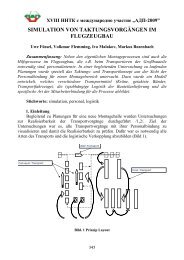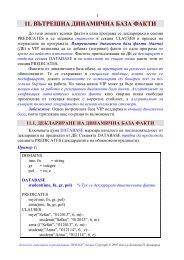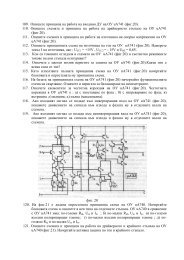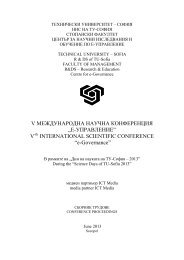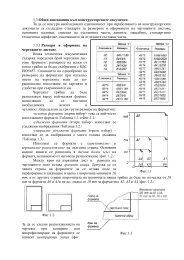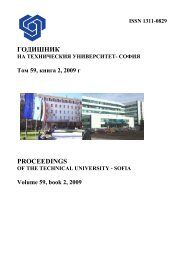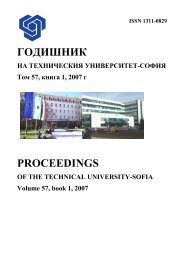Volume 61 Issue 2 (2011) - Годишник на ТУ - София - Технически ...
Volume 61 Issue 2 (2011) - Годишник на ТУ - София - Технически ...
Volume 61 Issue 2 (2011) - Годишник на ТУ - София - Технически ...
- No tags were found...
Create successful ePaper yourself
Turn your PDF publications into a flip-book with our unique Google optimized e-Paper software.
the soot precursors and soot particle formation and growth. Despite the numerous experimentaland theoretical studies for at least half of a century many questions remainunanswered. One of the reasons for the great interest on the acetylene combustion kineticsis due to its significant role in the process of soot formation. Several recentpublications describe the experimental and numerical investigations of the acetylenepyrolysis and oxidation in different combustion conditions [1-6].Acetylene oxidation is experimentally studied in an isothermal plug flow reactor(PFR) by Alzueta et al. [1]. The experimental results are simulated with an in-housechemical kinetic model where, the effect of temperature and stoichiometry on theacetylene conversion is studied. The authors draw special attention on the initiationreaction (C 2 H 2 + O 2 = ...) with its possible product channels and the subsequent acetyleneoxidation paths and the related derivatives. The authors point also on the H-abstractionreaction by the C-H bond fission and discuss the suggested reactions withthe related rate coefficients from several earlier investigations [3-6]. The initiationstep (C 2 H 2 + O 2 = ...) in [1] is represented by the reactions:C 2 H 2 + O 2 = CH 2 + CO 2 (1)C 2 H 2 + O 2 = 2HCO (2)with the rate coefficients adopted form [3]. The global reaction flow in [1], showedthe major reaction paths responsible for the acetylene oxidation and the main productformation channels. Accordingly, the acetylene is preferably oxidized in the reaction:C 2 H 2 + O = HCCO + H (3)Furthermore, the ketenyl radical (HCCO) is mainly oxidized by molecular oxygen toCO, CO 2 , H and OH. The authors [1] reported that the results are independent on thestoichiometry. The reactions C 2 H 2 + H + M = C 2 H 3 + M, and C 2 H 3 + O 2 = HCO +CH 2 O found to contribute significantly to the C 2 H 2 conversion in rich conditions.Nevertheless, their mechanism did not reproduce the temperature dependence of acetylenedecay as well as the T max of the CO and CO 2 profiles except for the much dilutedmixture. They stated that the slow C 2 H 2 conversion at low temperatures (T



